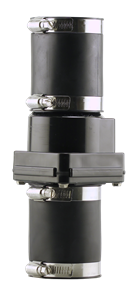Can I install the BSC-200-SB sump and sewage check valve vertically or horizontally?
Yes and no! The answer depends on the application.

A vertical installation is preferrable for a sump pump application.
However, if the valve is used for a sewage application it is crucial to abide by the industries standard installation practices. Sewage pump manufacturers state that when solids are being pumped, the check valve is not to be installed vertically, the valve must be installed either in the horizontal position or at a 45-degree position.
In addition, one must make sure that the valve is properly oriented with the flapper hinge (rubber valve pivot) at the top dead center position. Any deviation from this orientation will not allow the valve to operate properly and will result in valve or system failure.
The reason for horizontal or 45-degree installation in sewage applications is that in a vertical position, solids tend to lodge on the valve flapper and can prevent it from opening.
Failure to follow the proper valve orientation and flow rate guidelines are the most common reasons for valve failure. The rate of flow in the discharge pipe must keep any solids present in suspension in the fluid. To meet minimum flow requirements of 2 feet per second in a 2” discharge line the flow rate should not be less than 21 GPM. The velocity should never exceed 7 ft/s (73 GPM).
